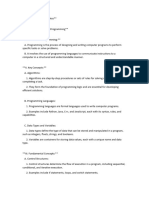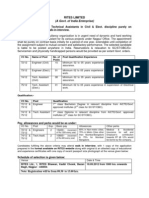Java Script syllabus
Uploaded by
nipor83948Java Script syllabus
Uploaded by
nipor83948### JavaScript Programming Syllabus for Secondary School Students
*Course Title:* Introduction to JavaScript Programming
*Course Duration:* One Academic Year (Two Semesters)
*Grade Level:* 9-12
*Course Description:*
This course introduces students to JavaScript, a key programming language for web development.
Students will learn the fundamentals of JavaScript, including syntax, data types, control structures, and
the Document Object Model (DOM). The course will include hands-on projects, allowing students to
create interactive web applications and games.
---
### Semester 1: Foundations of JavaScript Programming
*Week 1-2: Introduction to Programming and JavaScript*
- What is programming?
- Overview of programming languages and their uses
- Introduction to JavaScript: History and applications
- Setting up the development environment (text editors, browsers)
*Week 3-4: Basic Syntax and Data Types*
- Understanding JavaScript syntax and structure
- Variables and data types (strings, numbers, booleans)
- Basic input and output (console.log, alert)
*Week 5-6: Operators and Expressions*
- Arithmetic, comparison, and logical operators
- Understanding expressions and operator precedence
- Type coercion and type checking
*Week 7-8: Control Structures*
- Conditional statements (if, else if, else, switch)
- Introduction to loops (for, while, do...while)
- Practical examples and exercises
*Week 9-10: Functions*
- Defining and calling functions
- Function parameters and return values
- Understanding scope and hoisting
- Arrow functions and higher-order functions
*Week 11-12: Arrays and Objects*
- Creating and manipulating arrays
- Array methods (push, pop, shift, unshift, map, filter, reduce)
- Introduction to objects: properties and methods
- Object-oriented programming concepts (constructors, prototypes)
*Week 13-14: The Document Object Model (DOM)*
- Understanding the DOM and its structure
- Selecting and manipulating DOM elements (getElementById, querySelector)
- Event handling (click events, keyboard events)
*Week 15: Review and Assessment*
- Review of key concepts
- Midterm exam
---
### Semester 2: Intermediate JavaScript Programming and Projects
*Week 1-2: Advanced DOM Manipulation*
- Creating and removing elements dynamically
- Modifying styles and attributes
- Working with forms and user input
*Week 3-4: Introduction to Asynchronous JavaScript*
- Understanding asynchronous programming
- Callbacks, Promises, and async/await
- Making API requests using Fetch API
*Week 5-6: Introduction to Web Development*
- Overview of HTML and CSS basics
- Integrating JavaScript with HTML and CSS
- Building a simple interactive webpage
*Week 7-8: Introduction to Game Development with JavaScript*
- Basics of game development concepts
- Creating a simple game (e.g., Tic-Tac-Toe, Snake)
- Game loops and event handling
*Week 9-10: Working with APIs*
- Understanding RESTful APIs and JSON
- Making API requests and handling responses
- Building a small project using a public API (e.g., weather app)
*Week 11-12: Final Project Development*
- Students choose a project topic (interactive web app, game, etc.)
- Project planning and design
- Implementation and debugging
*Week 13-14: Project Presentations*
- Students present their final projects
- Peer review and feedback
- Discussion on challenges faced and lessons learned
*Week 15: Final Assessment*
- Comprehensive final exam
- Reflection on learning and future directions in programming
---
### Assessment Methods:
- Quizzes and homework assignments
- Midterm and final exams
- Group projects and presentations
- Individual coding assignments and lab work
### Resources:
- *Textbook:* "Eloquent JavaScript" by Marijn Haverbeke (or similar introductory text)
- *Online Resources:* MDN Web Docs, Codecademy, freeCodeCamp
- *Software:* Text editor (e.g., Visual Studio Code, Sublime Text), web browser (Chrome, Firefox)
### Additional Notes:
- Encourage students to participate in coding competitions or hackathons.
- Foster a collaborative environment where students can share ideas and help each other.
- Consider integrating guest speakers from the tech industry to discuss real-world applications of
JavaScript.
---
This syllabus aims to provide a comprehensive introduction to JavaScript programming while making the
subject engaging and relevant for secondary school students.
You might also like
- Future Coders Club - 24-Week Curriculum HTML, CSS and JSNo ratings yetFuture Coders Club - 24-Week Curriculum HTML, CSS and JS3 pages
- Tutorial-3-Client-side-scripting LanguagesNo ratings yetTutorial-3-Client-side-scripting Languages3 pages
- python programming syllabus for secondary school studentNo ratings yetpython programming syllabus for secondary school student5 pages
- JavaScript Beginning To Mastery SyllabusNo ratings yetJavaScript Beginning To Mastery Syllabus6 pages
- Asti Information Technology Department Course Syllabus - Javascipt Web Programming I. Course DescriptionNo ratings yetAsti Information Technology Department Course Syllabus - Javascipt Web Programming I. Course Description8 pages
- Enjoy an instant PDF download of the complete Test Bank for Introduction to JavaScript Programming with XML and PHP : 0133068307.100% (9)Enjoy an instant PDF download of the complete Test Bank for Introduction to JavaScript Programming with XML and PHP : 0133068307.47 pages
- Software Foundation and Programming Course Outline AINo ratings yetSoftware Foundation and Programming Course Outline AI3 pages
- ICodeDre Web Development Course SyllabusNo ratings yetICodeDre Web Development Course Syllabus4 pages
- 'Patanjali Gurukulam' Is The Gangotri of Knowledge: Sri Mohan BhagwatNo ratings yet'Patanjali Gurukulam' Is The Gangotri of Knowledge: Sri Mohan Bhagwat5 pages
- Incentives and Benefits Available To Ssi Entrepreneurs 1No ratings yetIncentives and Benefits Available To Ssi Entrepreneurs 18 pages
- Department of Education: Hon. Jonel V. TadayaNo ratings yetDepartment of Education: Hon. Jonel V. Tadaya3 pages
- The Riddle of The Schubert's Unfinished SymphonyNo ratings yetThe Riddle of The Schubert's Unfinished Symphony4 pages
- Caraga Regional Science High School: San Juan, Surigao CityNo ratings yetCaraga Regional Science High School: San Juan, Surigao City3 pages
- benchmarking in optimization- best practice and open issuesNo ratings yetbenchmarking in optimization- best practice and open issues50 pages
- (A Govt. of India Enterprise) : Rites LimitedNo ratings yet(A Govt. of India Enterprise) : Rites Limited3 pages
























































































